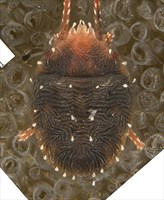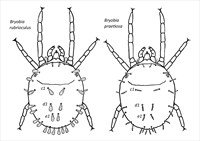Click on images to enlarge

Fig. 1. Bryobia praetiosa live adult female (photo by S. Learmonth).

Fig. 2. Bryobia praetiosa dorsal habitus - a. larva; b. protonymph; c. deutonymph; d. adult female; e. emergent peritreme; f. empodium (all redrawn from Geijskes (1939)).

Fig. 3. Bryobia larvae, dorsal habitus - B. rubrioculus (as B. arborea) and B. praetiosa (redrawn from Morgan & Anderson 1957).
Material examined
specimens not examined
Taxonomy
Subfamily Bryobiinae
Tribe Bryobiini
Common Name
clover mite
Distribution
+Australia, Argentina, Austria, Belgium, Bolivia, Brazil, CIS, Canada, Chile, China, Colombia, Costa Rica, Cyprus, Denmark, Egypt, Finland, France, *Germany, Greece, Greenland, Hawaii, hungary, India, Iran, Iraq, Ireland, Italy, Japan, Korea, Mexico, Morocco, New Zealand, Norway, Pakistan, Paraguay, Peru, Poland, Portugal, Rumania, South Africa, Spain, Sweden, Switzerland, Taiwan, The Netherlands, Turkey, United Kingdom, USA
Taxonomy Changes
Bryobia praetiosa Koch 1836
Bryobia latitans Livshits & Mitrofanov 1966, synonymy Livshits & Mitrofanov 1971
Bryobia pseuodpraetiosa Wainstein 1956, synonymy Waintstein 1960
Diagnosis
Larva (Figs 2a, 3)
- dorsal body setae lanceolate (Morgan & Anderson 1957; Miller 1966; Gutierrez & Schicha 1983) (Fig. 3)
- prodorsal setae v1 short, lanceolate + remaining body setae spatulate (Mathys 1961 - see Notes)
- prodorsum cuticle granulate
- opisthosoma cuticle weakly granulate with widely spaced striae
Female (Figs 1, 2d)
- empodium I short pad with one pair tenent hairs
- empodia II-IV pad with two rows of ventral tenent hairs (Fig. 2f)
- peritreme ending in elongate oval expansion, emergent from body and anastomosing (Fig. 2e)
- prodorsal setae v2 longer and broader than setae v1
- outer prodorsal lobes with broad bases, triangular
- wider at base than those of B. rubrioculus
- sometimes with swelling on inner margin
- indentation between inner and outer prodorsal lobes broad and shallow
- indentation between inner lobes relatively shallow
- setae v2 on outer lobes generally not (or just) reaching bases of setae v1 on inner lobes
- dorsal body setae spatulate, 27-33 long x 17-20 wide
- prodorsum coarsely granulate with thick irregular striae
- opisthosoma coarsely granulate with thick transverse (and oblique) striae
- stylophore with median notch distally
Hosts
Over 270 recorded species of host plant, including: Ageratum conyzoides, A. houstonianum (Asteraceae), Agropyron desertorum, Ag. smithii (Poaceae), Artemisia herba-alba, Ar. nova, Ar. tridentata, Artemisia sp. (Asteraceae), Atriplex cinerea, At. suberecta (Chenopodiaceae), Brassica juncea, Br. nigra, Br. oleraceae, Br. rapa (Brassicaceae), Bromus inermis, Bro. willdenowii, Bromus sp. (Poaceae), Chenopodium album, Ch. mbrosioides, Ch. murale (Chenopodiaceae), Chrysanthemum oronarium, Chr. nanseosus, Chrysanthemum sp. (Asteraceae), Convolvulus arvensis, Convolvulus sp. (Convolvulaceae), Cucumis sativus, Cucumis sp., Cucurbita moschata, Cu. pepo, Cucurbita sp. (Cucurbitaceae), Cydonia oblonga (Rosaceae), Cynodon dactylon, Dactylis glomerata (Poaceae), Dianthus caryophyllus, Dianthus sp. (Caryophyllaceae), Duranta repens (Verbenaceae), Euphorbia hirta (Euphorbiaceae), Ficus carica, F. palmata (Moraceae), Fragaria chiloensis, Fr. vesca, Fragaria sp. (Rosaceae), Galium aparine, Galium sp. (Rubiaceae), Hederea colchica, He. helix, Hedera sp. (Araliaceae), Hibiscus sabdariffa, Hibiscus sp. (Malvaceae), Hordeum arizonicum, Ho. vulgare (Poaceae), Ipomoea acuminata, Ipomoea sp. (Convolvulaceae), Litchi chinensis (Sapindaceae), Malus domestica, Malus sp. (Rosaceae), Malva hispanica, M. parviflora, Malva sp. (Malvaceae), Medicago hispida, Me. polymorpha, Me. sativa (Fabaceae), Passiflora edulis, P. quadrangularis (Passifloraceae), Pinus cembroides, P. douglasiana, P. pinceana, P. ponderosa, P. rigida, P. wallichiana, Pinus sp. (Pinaceae), *Poaceae, Prunus armeniaca, Pr. avium, Pr. domestica, Pr. dulcis, Pr. persica, Pr. serotina, Pr. triloba, Pyrus communis, Pyrus spp. (Rosaceae), Ribes alpinum, R. divaricantum, R. rubrum, R. uva-crispa (Grossulariaceae), Saccharum officinarum (Poaceae), Senecio burchelli, Se. cineraria, Se. niveus (Asteraceae), Solanum ducamara, So. melongena, So. tuberosum (Solanaceae), Trichilia emetica (Meliaceae), Trifolium alexandrinum, T. dubium, T. pratense, T. repens, Trifolium sp. (Fabaceae), Ulmus americana, U. pumila, Ulmus sp. (Ulmaceae), Vicia cracca, V. faba (Fabaceae), Vitis vinifera (Vitaceae)
Similar Taxa
Bryobia kissophila (Hedera spp.), B. ribis (Ribes spp.), B. rubrioculus (apple and pear) - see Notes
Biology
Bryobia praetiosa is generally found on herbaceous plants in temperate climates, and rarely occurs on trees. Commonly found on clovers in Tasmania. Large populations of this species may damage clover, lucerne and ryegrass, causing the foliage to turn yellow and wilt. Overwintering stages will sometimes invade houses.
References
Bolland H.R., Gutierrez J., and Flechtmann C.H.W. (1998) World Catalogue of the Spider Mite Family (Acari: Tetranychidae). Brill Academic Publishers, Leiden, 392 pp.
+Froggatt, W.W. (1921) Orchard and garden mites. No. 2 - Spinning mites (Family Tetranychidae). Agricultural Gazette Sydney 32: 130-135
Geijskes, D.C. (1939) Beiträge zur kenntnis der Europäischen spinnmilben (Acari, Tetranychidae), mit besonderer berücksichtigung der Niederländischen arten. Mededeelingen van de Landbouwhoogeschool te Wageningen (Nederland) 42(4): 1-68
+Gutierrez, J. and Schicha, E. (1983) The spider mite family Tetranychidae (Acari) in New South Wales. International Journal of Acarology 9: 99-116
*Koch, C.L. (1936) Deutsche Crustacea, Myriapoda, Arachnida, Fasc. I.
Livshits, I.Z. and Mitrofanov, V.I. (1966) The systematic position of the species in the genus Bryobia C.L.Koch, 1836, and the description of five new species (Bryobiidae, Acariformes). Zool. Zh. 45: 836-849
Livshits, I.Z. and Mitrofanov, V.I. (1971) The mites of the genus Bryobia C.L. Koch, 1836 (Acariformes, Bryobiidae). Tr. Gos. Nikit. Bot. Sada 51: 1-112
Mathys, G. (1957) Contribution a la connaisance de la systematique et de la biologie du genre Bryobia en Suisse romande. Bulletin Societie Entomologique de la Suisse 30: 189-284
Mathys, G. (1961) Note sur l'espece Bryobia praetiosa (Acarien, Tetranychidae). Annuaire Agricole de la Suisse 62: 295-304
Migeon, A. and Dorkeld, F. (2006-2017) Spider Mites Web: a comprehensive database for the Tetranychidae. http://www.montpellier.inra.fr/CBGP/spmweb
Morgan, C.V.G. and Anderson, N.H. (1957) Bryobia arborea n. sp. and morphological characters distinguishing it from B. praetiosa Koch (Acarina: Tetranychidae). The Canadian Entomologist 89(11): 485-490
Wainstein, B.A. (1956) Fauna of tetranychoid mites in South Kazakhstan. Zool. Zh. 35: 384-391
Wainstein, B.A. (1960) Tetranychoid mites of Kazakhstan (with revision of the family). Kazakh. Akad. Sel'sk. Nauk. Nauch. Issled. Inst. Zashch. Rast. Tr. 5: 1-276
Notes
Since the first description of B. praetiosa, there has been confusion over the exact diagnosis of this species. None of Koch's original specimens are known to be available, and hence much information is the result of speculation. Van Eyndhoven (1956, 1958) collected specimens from the original locality and these are considered to be true B. praetiosa. Mathys (1957, 1961) made critical contributions to the taxonomy of this species through use of the larvae, as did Morgan & Anderson (1957). Bryobia rubrioculus has long been confused with B. praetiosa.
Morgan & Anderson (1957) indicated how to separate praetiosa from rubrioculus by using the larvae (Fig. 1), and with characters of the female. The two species can be separated using the length of the idiosoma, and distance between dorsal opisthosomal setae of the female: idiosoma Br 636, Bp 878; c1-c1 64 Br, 142 Bp; d1-d1 45 Br, 122 Bp; e1-e1 32 Br, 85 Bp.
Womersley apparently identified all Australian Bryobia as praetiosa (Gutierrez & Schicha 1983).
Copyright © 2018. All rights reserved.